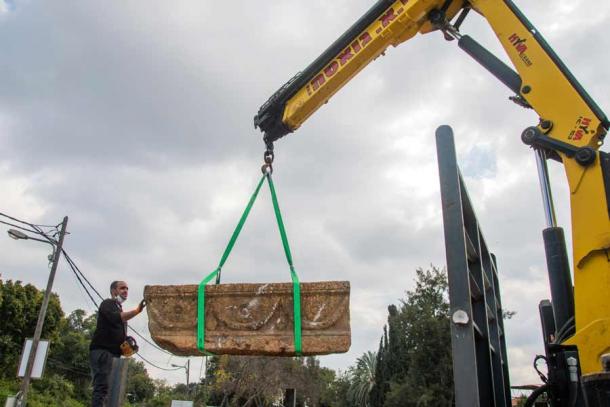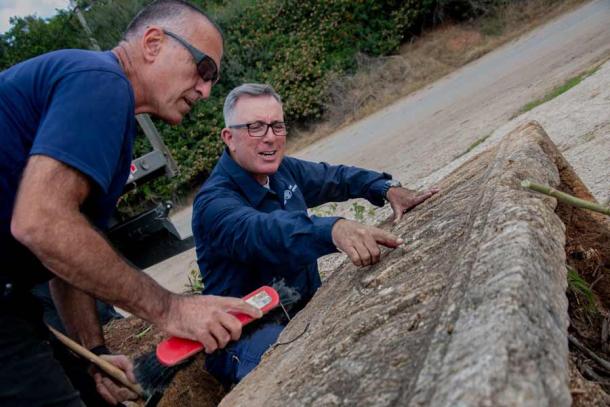Construction workers in Israel have rediscovered a pair of ancient stone Roman coffins that had been found 25 years earlier and then forgotten. The two Roman-era (63 BC-324 AD) stone sarcophagi were unearthed at the Ramat Gan Safari Park in Tel Aviv, Israel. Archaeologists with the Israel Antiquities Authority (IAA) say the pair of highly-ornate Roman coffins display mystical symbols that were believed to protect souls on their way to the afterlife.
Roman Coffins From The Bnei Brak Roman Period
The two stone Roman coffins were originally discovered 25 years ago during the construction of a parking lot. The researchers told Times of Israel that the sarcophagi were subsequently “forgotten and became overgrown with vegetation and dirt.”
The team of IAA archaeologists said the site where the ancient coffins were discovered is near the Safari Park, in the region of Messubim, a northeastern suburb of Tel Aviv–Yafo, west-central Israel, in the southern Sharon plain .
In the Roman period this site was called “Bnei Brak,” which is known to archaeologists from the “ Passover Haggadah, ” a Jewish text that sets forth the order of the Passover Seder . The city is also mentioned in the Bible ( Joshua 19 ), and in Assyrian texts.
Bnei Brak fell to Sennacherib, king of Assyria, in 701 BC.

One of the “forgotten” Roman coffins being lifted up from where it was found next to another coffin, which were likely created for a married elite Roman couple. ( Israel Antiquities Authority )
Ancient Uniquely Decorated “His And Hers” Roman Coffins
IAA Archaeologist, Uzi Rothstein, has now confirmed that the two coffins are “a matching pair.” In an article in lsrael 21c , the researcher said that when the workers started digging they noticed something sticking out of the ground. “They kept digging and revealed something incredible – two unique, stone-carved sarcophagi – ancient coffins that are 1,800-years-old.” Furthermore, because identical symbols, garlands and discs, were found on both sarcophagi, Rothstein thinks they were ‘his and hers,’ “made for a husband and wife.”
The sarcophagi are ornately decorated with funerary garlands and discs which were both high-status symbols in the Roman period. The disc symbols, in particular, are of special interest to the researchers because they might have served “a mystical function after death.”
The IAA said the sarcophagi are decorated with symbolic discs because this symbol was believed to “protect and accompany the soul on its journey to the afterlife.”
What’s more, the garlands are separated with oval blanks which the researchers believe were intended to be illustrated with grape-cluster motifs, “but for some unknown reason, the work remained unfinished.”
According to the archaeologists, the sarcophagi were “likely made to imitate well-known coffins carved from Proconnesian marble from the Turkish island of Marmara.” Rather than using the more expensive marble, however, the two coffins were most likely carved from stone sourced in central Israel, in the Judean Hills west of Samaria.

Two Israeli archaeologists using a brush to clean debris from one of the Roman coffins recently “re-discovered” in Israel. ( Israel Antiquities Authority )
Israel’s Roman Period: Extreme Poverty And Affluence
The Roman period in Israel lasted around four hundred years, during which time it heavily influenced culture and arts. Magnificent mosaics, burial portraits, jewelry, and sculptures have been found adorning the public spaces of ancient Roman cities in the Holy Land. According to an article on IMJ Roman rule provoked unrest among the Jews which culminated in the Bar Kokhba revolt (132-136 AD).
This revolt was eventually quashed, putting an end to Jewish hope for political independence and widespread destruction spread across the Land.
Many fleeing rebels hid in caves on the steep slopes of the Judean Desert gorges, where they hid their household items, weapons, and legal documents. The items that have been discovered in these caves offer a glimpse into the bitter, daily Jewish life of this period, and they represent the death of thousands of Jews in those caves.
In stark contrast to the horrors of cave-dwelling, and surviving day to day, the lives of rich Romans were so lush that they had the time and money to worry about how to symbolically protect their souls in the afterlife.
The two Roman coffins decorated with garlands and discs are examples of an empire at its height, when all threats had been quelled, when wealth was so abundant it could be spent on the afterlife.
Top image: A closeup of one of the Roman coffins showing the symbolic disks. Source: Israel Antiquities Authority
By Ashley Cowie
Related posts:
Views: 0
 RSS Feed
RSS Feed















 February 23rd, 2021
February 23rd, 2021  Awake Goy
Awake Goy  Posted in
Posted in  Tags:
Tags: 
















